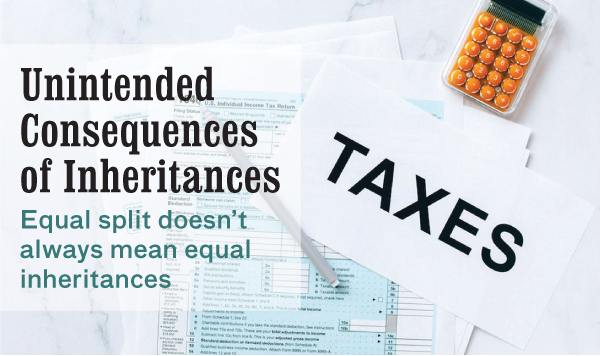
It’s common for parents to want to give their money to their children in equal amounts. If you have three children, for example, you may want to leave one-third of your assets to each child when you pass away. While the logic makes sense, simply stating that in your will could create unintended consequences, higher taxes and anything but an equal split.
It’s important to look at where each of your children are in their life and what it looks like to split all of your assets three ways. It might make sense to collaborate and see where each person is in their life, what their tax situation is and what assets given to what child can make the most sense.
Taxes Are a Big Consideration
Let’s look at a situation where all of your children are in their 40s. One is a partner in a law firm in New York City earning $450,000 a year (call her Melissa) and the other two children, Gary and Ron, are making $125,000 per year working corporate sales jobs and they live in Texas and Tennessee, respectively. Let’s assume that you have an IRA worth $600,000 and a home worth $300,000 with no mortgage. If you were to leave one-third of your assets to each of your children that means each gets $200,000 of your IRA and when the home is sold, they each get $100,000 in cash from the sale of the home. This sounds pretty fair because everyone got $300,000 in total value, right?
That is correct before taxes, but it is not the case after taxes are paid. Assume Melissa and Gary are married but Ron is still single. Melissa’s husband makes $150,000 and Gary’s wife is a stay-at-home mom.
Because Ron is single, he is likely in the 24% tax bracket while Gary is in the 22% bracket, because he files “married filing jointly.” Because Melissa is a high-income earner and her husband is working as well, they are in the 35% tax bracket.
Not All Assets Are Treated the Same
Under current tax law, when someone passes away, their house (as well as stocks and many other investments) receive what is called a “step-up in basis” and gets passed to the heirs at the current market value. This means that although mom and dad bought the house for $78,000 some 30 years ago, when they pass away and the house is worth $300,000 the children don’t need to pay tax on the gain. They receive the house at the $300,000 value and if they sell it for that amount, there is no taxable gain and therefore no tax.
The IRA, on the other hand, is treated as ordinary income and it can be taken as either a lump sum or can be deferred and taken over the course of the next 10 years. When distributions are taken from the IRA by the children, they have to pay taxes on that money at their current rate of tax as though it was income they earned.
The Unintended Consequence
As you may have figured out from the above section, none of the three children pay taxes on the home sale proceeds so they are left with $100,000 each. That’s great.
With the IRA, let’s assume each child takes out 10% per year, or $20,000 apiece, then Michelle would be paying $7,000 in federal income tax plus New York state income tax of $1,370. This leaves her with $14,370. Over 10 years she will have $143,700 in net cash that she was left with after taxes. Ron, in contrast, would pay 24% tax, thus $4,800 in federal income tax per year, while Gary would pay $4,400 of tax. Both Ron and Gary live in states with no state income tax, so over the next 10 years they are left with $152,000 and $156,000 respectively. As you can see Gary ends up with the most money by over $12,000 more than Melissa and $4,000 more than Ron. Nobody benefited from this allocation except the IRS and the state of New York.
Consider instead leaving the home to Melissa and the IRA to the boys and taxes will be decreased. Melissa wouldn’t have any gain and therefore would avoid the income taxes and the boys will each get only slightly less. Of course, you can plan in such a way that it makes it that each get the exact same amount.
Other Considerations
Aside from the tax planning and asset distribution, it’s often a good idea to consider distributions during your lifetime, so that if you were in the 12% tax bracket in retirement or even the 22% bracket, taking distributions from the IRA would mean you pay the taxes and you can set the assets aside for your children to inherit. This prevents them from paying taxes at higher rates when they inherit the money.
You might also want to consider your relationships with your adult children and who is doing the most for you. If you lived in Texas and Gary’s family comes by to check on you, picks up groceries and takes you to doctor appointments, maybe a larger allocation makes sense to give to him. I’m sure Melissa, who lives 1,000 miles away and makes a sizeable living, wouldn’t be opposed to that scenario. Perhaps one of the children has children of their own and another doesn’t, or they do charity work that you also support. Open conversation with your children can make all the difference in keeping more money in your family and giving less to the government.
___
If you are looking for a financial advisor who can help you with tax planning, reach out to Red Barn Financial.
(Disclaimer: The information provided in this article is not tax, legal or financial advice. The individuals noted are fictitious and for example purposes only. Your situation may be different. New York state taxation in this scenario may differ depending on potential exemptions available at the time.)













